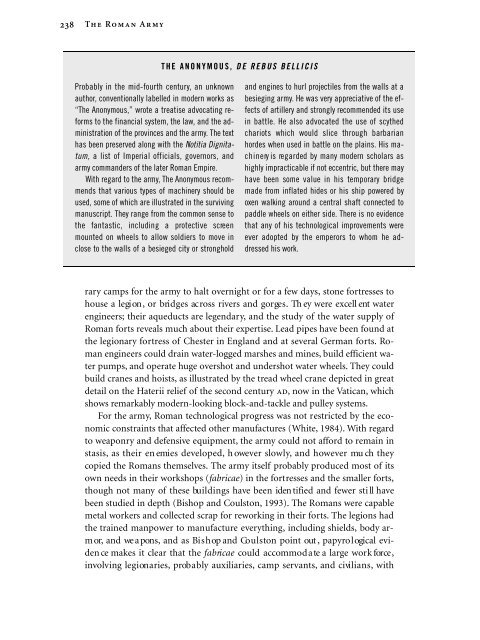The Roman Army: A Social and Institutional History - Karatunov.net
The Roman Army: A Social and Institutional History - Karatunov.net
The Roman Army: A Social and Institutional History - Karatunov.net
You also want an ePaper? Increase the reach of your titles
YUMPU automatically turns print PDFs into web optimized ePapers that Google loves.
238<br />
<strong>The</strong> <strong>Roman</strong> A rmy<br />
P robably in the mid-fourth century, an unknown<br />
author, conventionally labelled in modern works as<br />
“<strong>The</strong> Anonymous,” wrote a treatise advocating reforms<br />
to the financial system, the law, <strong>and</strong> the administration<br />
of the provinces <strong>and</strong> the army. <strong>The</strong> text<br />
has been preserved along with the Notitia Dignitat<br />
u m , a list of Imperial officials, governors, <strong>and</strong><br />
army comm<strong>and</strong>ers of the later <strong>Roman</strong> Empire.<br />
With regard to the army, <strong>The</strong> Anonymous recommends<br />
that various types of machinery should be<br />
used, some of which are illustrated in the surviving<br />
manuscript. <strong>The</strong>y range from the common sense to<br />
the fantastic, including a protective scre e n<br />
mounted on wheels to allow soldiers to move in<br />
close to the walls of a besieged city or stronghold<br />
THE ANONYMOUS, DE REBUS BELLICIS<br />
<strong>and</strong> engines to hurl projectiles from the walls at a<br />
besieging army. He was very appreciative of the effects<br />
of artillery <strong>and</strong> strongly recommended its use<br />
in battle. He also advocated the use of scythed<br />
chariots which would slice through barbarian<br />
hordes when used in battle on the plains. His mac<br />
h i n e ry is re g a rded by many modern scholars as<br />
highly impracticable if not eccentric, but there may<br />
have been some value in his temporary bridge<br />
made from inflated hides or his ship powered by<br />
oxen walking around a central shaft connected to<br />
paddle wheels on either side. <strong>The</strong>re is no evidence<br />
that any of his technological improvements were<br />
ever adopted by the emperors to whom he addressed<br />
his work.<br />
rary camps for the army to halt overnight or for a few days, stone fortresses to<br />
house a legi on , or bri d ges ac ross rivers <strong>and</strong> gor ge s . Th ey were excell ent water<br />
engineers; their aqueducts are legendary, <strong>and</strong> the study of the water supply of<br />
<strong>Roman</strong> forts reveals much about their expertise. Lead pipes have been found at<br />
the legionary fortress of Chester in Engl<strong>and</strong> <strong>and</strong> at several German forts. <strong>Roman</strong><br />
engineers could drain water-logged marshes <strong>and</strong> mines, build efficient water<br />
pumps, <strong>and</strong> operate huge overshot <strong>and</strong> undershot water wheels. <strong>The</strong>y could<br />
build cranes <strong>and</strong> hoists, as illustrated by the tread wheel crane depicted in great<br />
detail on the Haterii relief of the second century ad, now in the Vatican, which<br />
shows remarkably modern-looking block-<strong>and</strong>-tackle <strong>and</strong> pulley systems.<br />
For the army, <strong>Roman</strong> technological progress was not restricted by the economic<br />
constraints that affected other manufactures (White, 1984). With regard<br />
to weaponry <strong>and</strong> defensive equipment, the army could not afford to remain in<br />
s t a s i s , as their en emies devel oped , h owever slowly, <strong>and</strong> however mu ch they<br />
copied the <strong>Roman</strong>s themselves. <strong>The</strong> army itself probably produced most of its<br />
own needs in their workshops (fabricae) in the fortresses <strong>and</strong> the smaller forts,<br />
t h o u gh not many of these bu i l d i n gs have been iden ti f i ed <strong>and</strong> fewer sti ll have<br />
been studied in depth (Bishop <strong>and</strong> Coulston, 1993). <strong>The</strong> <strong>Roman</strong>s were capable<br />
metal workers <strong>and</strong> collected scrap for reworking in their forts. <strong>The</strong> legions had<br />
the trained manpower to manufacture everything, including shields, body arm<br />
or, <strong>and</strong> we a pon s , <strong>and</strong> as Bi s h op <strong>and</strong> Co u l s ton point out , p a pyro l ogical eviden<br />
ce makes it clear that the f a b ri c a e could accom m od a te a large work force ,<br />
i nvo lving legi on a ri e s , prob a bly auxiliari e s , camp serva n t s , <strong>and</strong> civi l i a n s , wi t h










